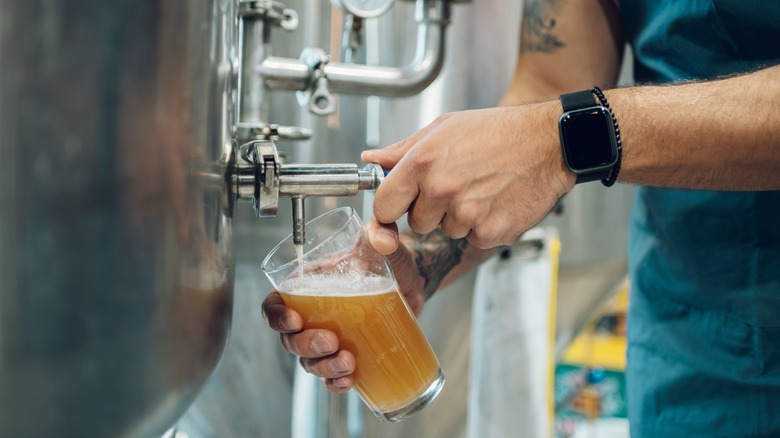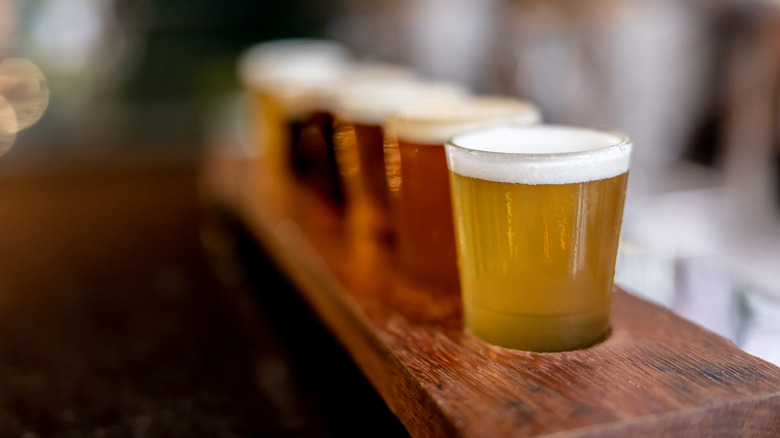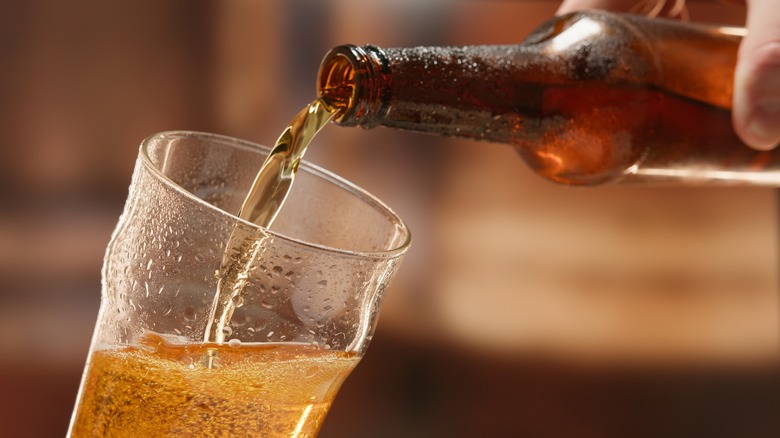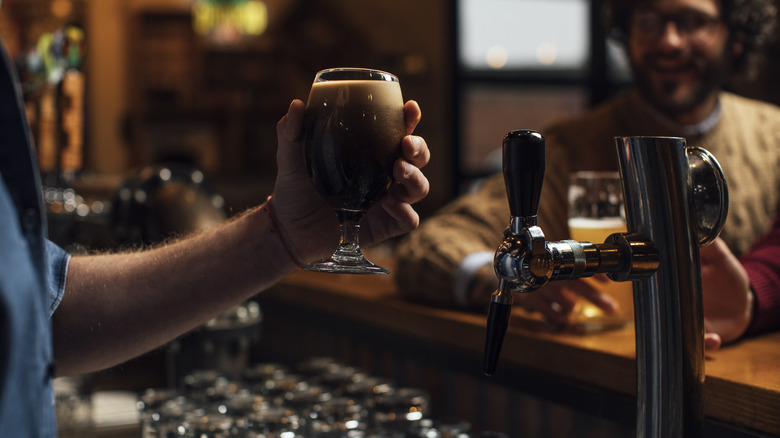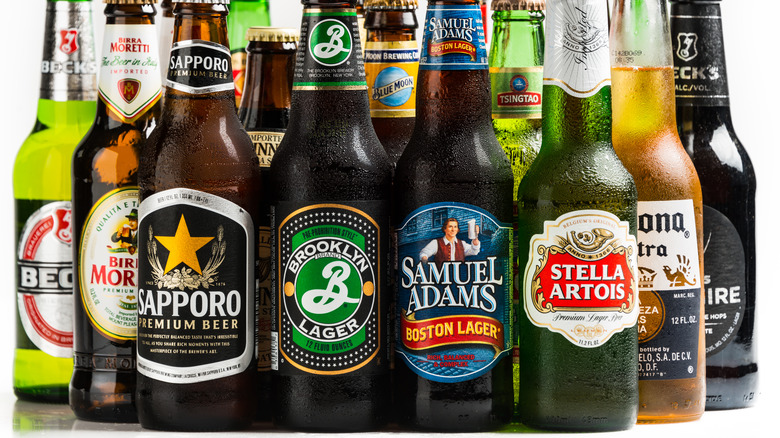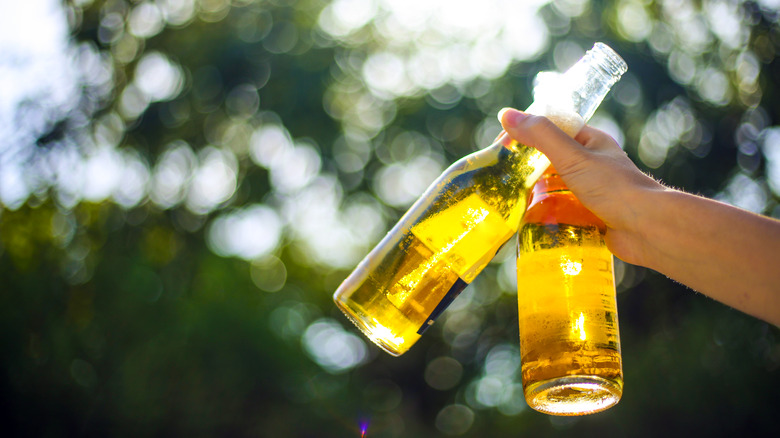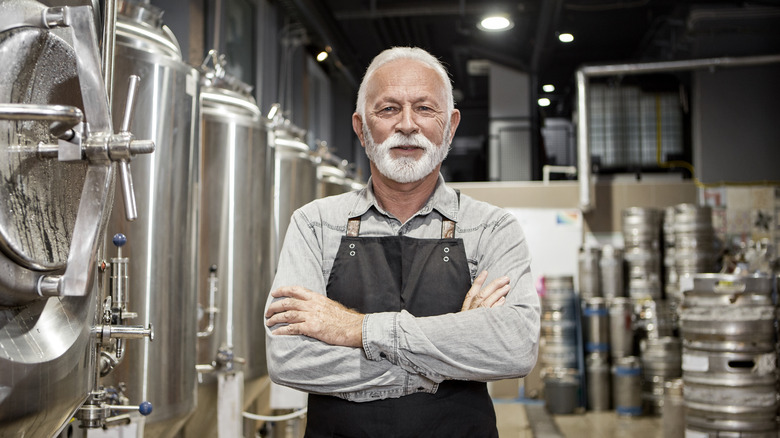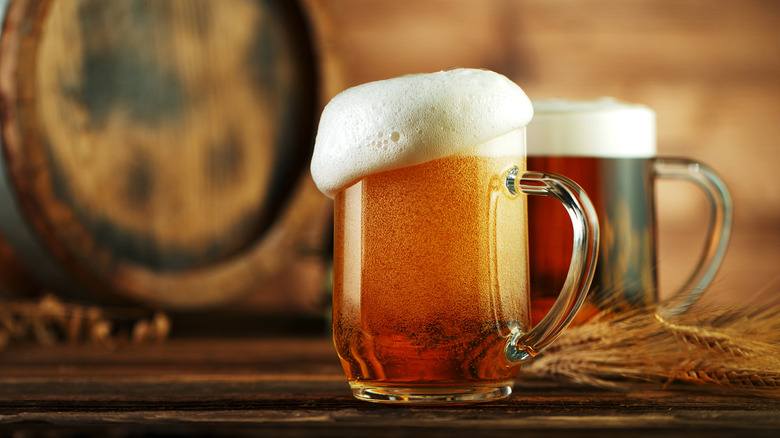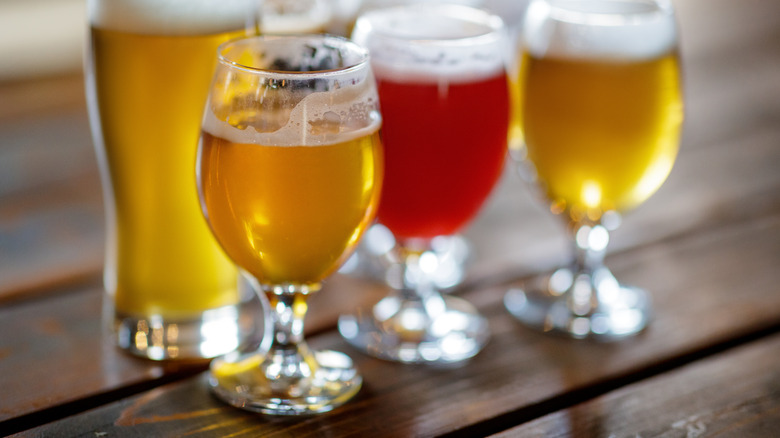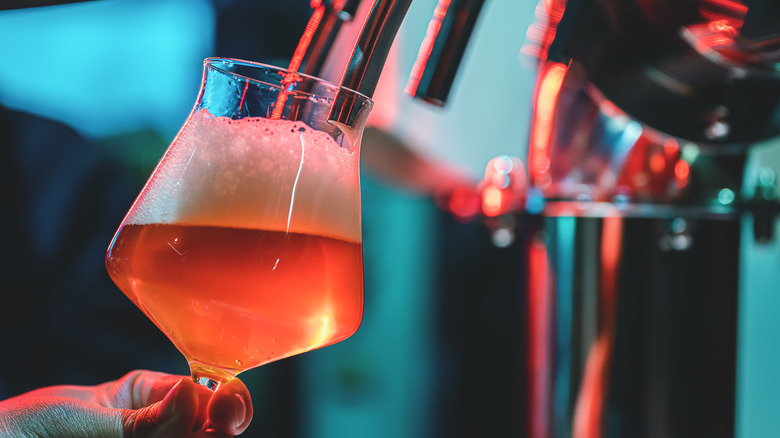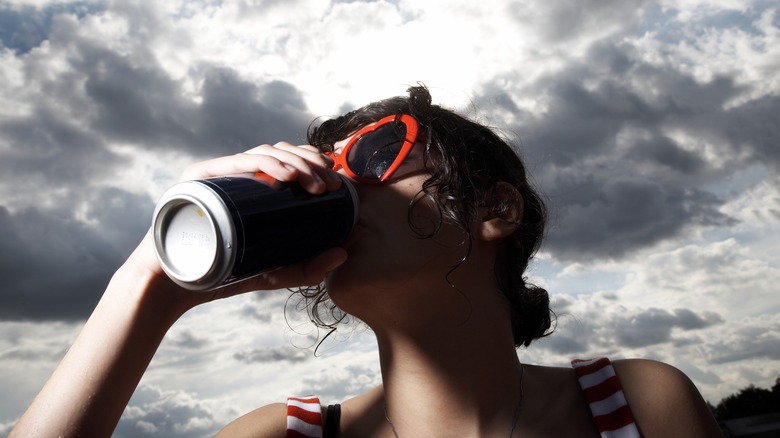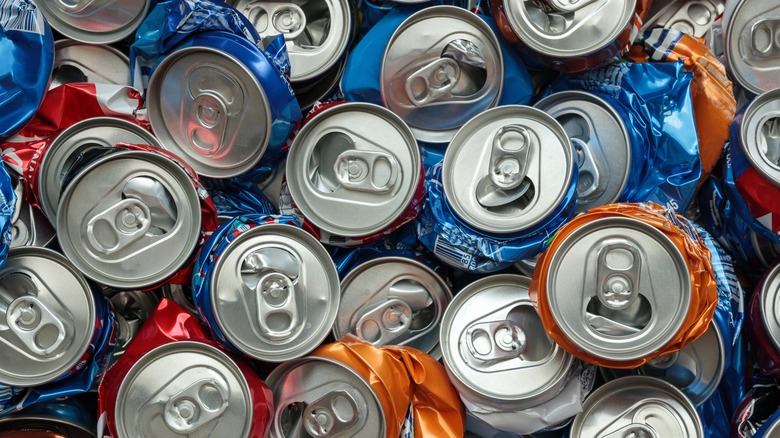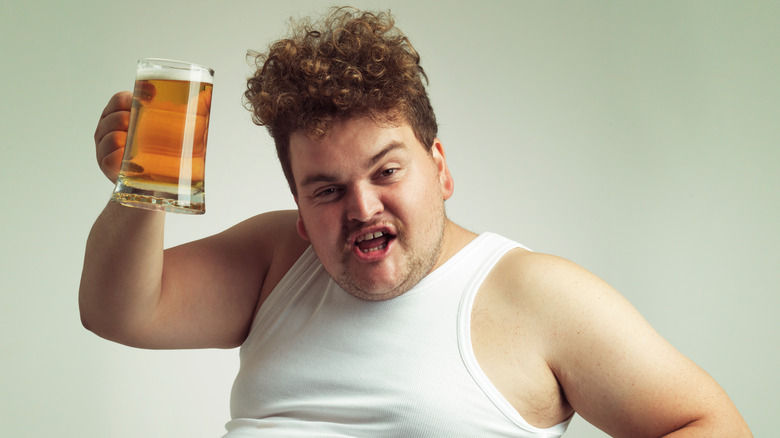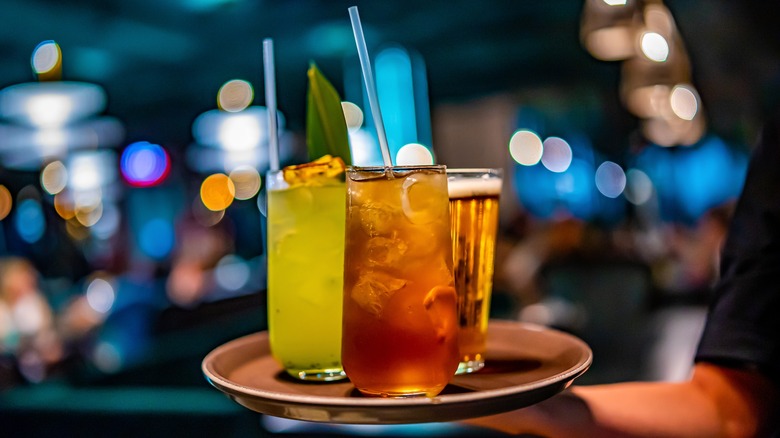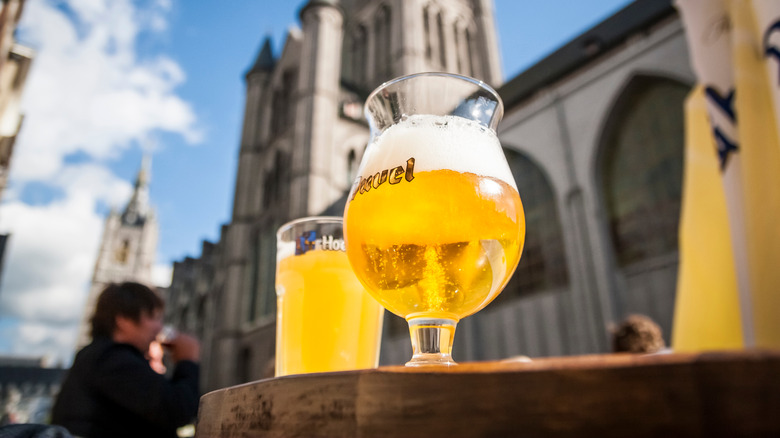15 Myths You Thought Were True About Beer
There's no denying that the beer industry is huge. Revenue for beer (in the United States) in 2023 will amount to around $120.6 billion. And, of course, beer is part of many cultures around the world — from Bavaria to Ireland, Japan to South America, beer is richly embedded in history. But drinking beer can be a polarizing experience — you might love it, but also find a particular style way too bitter.
There are so many types of beer, from pale ale to porter, IPAs to craft Belgian-style brews, and infinitely more — the choices can be overwhelming for some people, and there's no wonder why there are a lot of misconceptions when it comes to beer. Because there still seems to be some confusion around this beverage, we wanted to shed a little light on the subject. Here are 15 of the biggest myths about beer.
Most beers are basically the same
All beers aren't the same, even if some people just are looking to enjoy one, no matter what the taste is. While it is true that beers are either ales or lagers because of the yeast utilized during the fermentation process, there are variations that create different styles. There are more than 100 styles of beers throughout the world.
People may think that if beers looks similar they will taste similar, too. But that couldn't be farther from the truth. Comparing a pilsner — which tends to be golden in color — with a double IPA, which can also be golden hued, isn't a comparison worth making. Pilsners are more crisp and refreshing and are golden because of the "lagering" during processing. These two may be the same color but are not even close to tasting the same. And that's just one example — try comparing the taste of a sour to a porter!
Also, certain beers taste more hoppy, and that's (of course) because they have more hops. These are most likely ales, such as pale ales or India pale ales (IPAs), where you get the forwardness of the flower within every sip.
All beers should be served cold
Beer is a premium drink when you're sitting outside on a hot day. While that is arguably the optimal forecast for beer drinking, there are certain occasions when beer is meant to warm you up — a spiced ale, for example, during the holidays is perfect around the fireplace. While you may believe that beer is best served cold — and we won't argue — it doesn't mean it's the only way it should be served.
Ales tend to be enjoyed more frequently when they are cold, as they have a crispness to them that's refreshing. But cask beers, something that you'll traditionally find in the U.K., are served warmer than most out of a keg. Cask ale, or "real beer" is one that goes through a secondary fermentation in the cask. You may have been to Britain and seen a bartender pull a long handle multiple times to draw beer into a glass. That's coming from a cask and it tends to be served a bit warmer, as almost half of cask ale in the U.K. is served warmer than optimal drinking temperatures. However, beer served like this doesn't mean it's any less enjoyable.
Dark beer is always stronger than light beer
You may see a dark beer and assume it's going to sit more heavily in your stomach. It's a natural thought, just based on the complex of light versus dark. But a dark beer can not only be lighter in taste than a light beer, it can also be less strong. An average beer is 5% alcohol by volume (ABV), which is the standard measurement of how much alcohol is in a specific amount of a drink. Guinness Draught – one of the most well-known beers around the world — is an Irish stout and is 4.2% ABV, despite its dark complexion.
On the opposite side, something like Flying Dog's Double Dog or Firestone Walker's Mind Haze, which are golden in color, are double IPAs, and have ABVs of 12% and 8.3%, respectively. It all depends on the amount of alcohol in the drink, rather than the color. So don't be fooled by thinking you're drinking a much less strong beer just because it's lighter in color.
Craft beers are all specialty beers
You may hear the word "craft beer" and assume it's going to be a specialty beer that you can only find in certain areas, so you have to collect them. You may also think craft beer is slightly different from a classic lager or ale, making it less likely that you'll enjoy this brew. But craft beers are beers that come from independent breweries, meaning that it isn't made in a large mechanized way by a massive distributor or producer. Basically, if a brewery isn't owned by a larger corporation, it's considered a craft brewery and it produces craft beers.
Some of the most common beers you'll see in the United States are considered craft beers. Pictured above are Samuel Adams Boston Lager and Brooklyn Brewery's Brooklyn Lager, two beers that you're likely to find in just about any state in the country. Both of those are craft beers because the breweries are independently owned.
If cold beer gets warm, it goes bad
When you put your beer into the refrigerator or a cooler, it's so you can enjoy a nice, cold, refreshing beer. But if it comes out of the fridge or cooler and sits out in the sun for a while, some people may think that the beer goes bad. That isn't the case, specifically. However, the way beer can go bad is when too much light gets into the bottle and causes the hops to start a photooxidation reaction, which can ultimately make the beer taste, well, less good. For hoppier beers, you're more likely to see bottles that are darker in color to prevent that.
Certain beers that aren't overly hoppy may come in lighter-colored bottles, such as Corona or Landshark. But just because you let a beer sit out of the fridge for a bit doesn't mean it'll go bad. But just because you let a beer sit out of the fridge for a bit doesn't mean it'll go bad. Then again, if you prefer cold beers, keep them on ice.
Beer can't go bad
Beer can go bad. But "bad" may be a subjective term because some people will drink it regardless of how it tastes. The expiration date you see on bottles is more for show. Think of it as a tactic to sell more beer, because it's basically reminding you that you've had a beer a long time in your refrigerator. You should be storing beer in a fridge for the optimal drinking experience. A massive change in temperature, such as having it in a fridge and then taking it out and leaving it in a warm garage for a long time, is more likely to affect the beer's taste than how old it is.
So if you're keeping beer in the refrigerator for a long time and take it out to drink, it's going to last longer than a beer that has been sitting out. In fact, a change in temperature can make it taste "bad" or "skunked." Beer stored in a warmer setting can taste more sour or off. Keeping beer safe and away from lots of sunlight will make it drinkable for longer. So you can use those expiration dates on the beer as you see fit.
Pouring a beer upside-down will cause more foam and make it less tasty
You have probably tried to minimize the amount of foam when you're pouring from a can or bottle to get more of the beer into the glass. You have tilted the glass, and you have tilted the bottle or can at a 45-degree angle to avoid the buildup of bubbles. But some foam (referred to as head) on a beer, is a good thing. It adds aroma to the beer, which is desirable when you're about to sip. It also doesn't let carbonation escape from the beer quickly, preventing it from going flat. The froth is what you want because it helps mimic a draft pour.
Guinness has invented the Guinness widget, which is a small white nitrogen ball that you'll find in a Guinness Nitro can. This helps the beer interact with the glass as if it's being poured from a tap. On the can, it tells you to turn the beer upside-down in order to pour it. That helps the carbonation reach maximum levels.
Aging craft beers is the way to go
Buying a specialty beer with a crazy logo on the can or a hilarious name that you found funny can be a highlight of going to your local liquor store or brewery. But just because it is a beer that you may not see everywhere doesn't mean you have to store it for a long time. Aging craft beers isn't something that you have to do — but if they have a higher ABV, they can actually get better with age.
There are some rules, however, that could stop you from enjoying the beer at its best if you wait to drink it. For instance, if the beer has a higher ABV, but also includes lots of hops or fruit flavors, the flavor components tend to break down over time — meaning it won't taste as good as it did when it was fresh. For beers that have a lower ABV, you can drink them anytime.
All sour beers are really tart
Sour beer is categorizedby having a purposefully sour or acidic taste. There are plenty of sour beer styles, including German gose or Berliner Weisse and Belgian lambics or gueuze. During the fermentation process, wild yeasts and bacteria strains are intentionally added to turn the taste of the beer more sour. If you're worried that you'll be drinking the beer and have your lips pucker every time, fear not. Lots of sours won't make you feel like you're sucking on a Warhead (though Artisanal Brew Works created a Warheads-themed beer line that is extra sour.)
For example, fruit-forward sour beers allow for a sweeter take on traditional beer. Prairie Artisan Ales' Watermelon Girlfriend is 5% ABV that gives you plenty of watermelon flavor with a bit of sea salt. Sierra Nevada's Wild Little Thing actually has "slightly sour" in its description and has guava, hibiscus, and strawberry for a sweeter-than-sour taste.
Beer from a can tastes different than beer from a bottle
Grabbing a cold can out of a cooler and cracking it open is a peak summer moment for many. That the beer is in a can isn't what makes it a peak moment, however. Sure, cans may be easier to handle than bottles — bottles can break which can cause a big mess. But the beer in the bottle is the same as the beer in the can. If you think the beer tastes differently, it's likely because of the way it was stored, and also the temperature of the beer. As we've discussed, beer bottles tend to be darker to avoid having a beer's taste affected by sunlight.
Cans also help preserve the taste because they aren't as subject to light infiltration. And they're better for the environment because aluminum is easier to transport than glass, resulting in a smaller carbon footprint. Also, aluminum is the only beverage container that is infinitely recyclable, according to The Aluminum Association. While cans still need to be stored properly, the beer isn't different when it comes to what's in a can and what's in a bottle.
Canned beer costs less
While you may remember a time in your life, probably when you were in college, when you were looking at purchasing beer in larger quantities and saw that a 24-pack of canned beer was relatively inexpensive, it isn't true that beer in a can is always cheaper than in a bottle. Sure, it may seem that canned beer is easier to dispose of and bottles could make a mess at a house party — but when it comes to cost, it's not a blanket rule.
There are plenty of specialty packs of beer at liquor stores that you'll find cost a pretty penny. Four-packs of beer from a craft brewery can cost around $20 to $25 at your local store while a 24-pack of bottles of light beer can cost $18. While this may be a specific example, there are a lot of cases where bottles of beer cost less than a can of beer. It's more about the beer inside than the vessel it's in.
Beer is bad for you
There's no question that a lot of beer can be bad for your health. Drinking too much beer will add empty calories to your diet and can lead to cirrhosis of the liver. If you're worried about gaining a lot of weight from beer, that has more to do with metabolism, overall diet, and how active (or inactive) you are. "Some studies have also shown that drinking alcohol can increase your appetite in the short term, causing you to eat more than you otherwise would" (via Healthline).
However, drinking beer in moderation can actually be good for your health. It has been found that it can lower risk of diabetes, may help you build strong bones, can hydrate you, and even boost brain power (per NBC News). Drinking beer — as with any alcohol — is about moderation.
Beer before liquor, you've never been sicker -- liquor before beer, you're in the clear
If you're someone who started drinking at the age of 21, you might have heard the adage, "Beer before liquor, you've never been sicker. Liquor before beer, you're in the clear." This refers to having some liquor before beer in order to avoid getting sick afterward. While some people have used this to try and avoid hangovers, there is no scientific proof that drinking beer before you drink liquor will make you sick.
The quantity of drinks that you're consuming when you're getting sick is more likely a result of the ABV of what you're drinking. Other factors include how much food you have in your stomach — food can help soak up alcohol. Also, sensitivities to alcohol could lead to you getting sick. And in general, mixing alcohol can be disastrous, as they all have different ABV, so it may be harder to keep track of what you're consuming.
Draft beer is the best for taste
A refreshing beer poured from a tap that comes out with a bit of head is picturesque. But it is a matter of preference as to whether or not draft beer tastes better. You may have noticed different shapes and sizes of beer glasses when you order at a bar or restaurant. Each glass can unlock various aromas and flavors of the beer, helping it taste its best. Pilsner glasses, pint glasses, tulip glasses, and more accentuate the beers that they hold.
But just because the beer is poured from a tap doesn't mean it's going to taste great. Dirty draft lines can cause bacteria to build up and turn the beer. There are a lot of times you're better off ordering a can or a glass. Unfortunately, you may have to taste a beer from a dirty draft line to realize it's not very good — in these instances, swap it out and order a can.
Beer shouldn't have sediment
You take a beer from the bartender and look at the glass. You see some form of sediment floating in it. Immediately, you may think something is wrong with the beverage. But sediment in beer just means the beer is unfiltered, which is a totally normal way to prepare beer — it doesn't mean the beer is unsafe to drink.
A small amount of sediment is natural for a beer, especially for cloudy or hazy beers like IPAs of German Hefeweizen. If beer has sat for a longer time in a keg or on a shelf, the protein can fall out and create a thin layer of sediment. The sediment is yeast, which is packed with B vitamins, meaning it will not make you sick and is actually beneficial to your health. So if you happen to order one of these styles and notice sediment floating in your beer, drink and enjoy!

